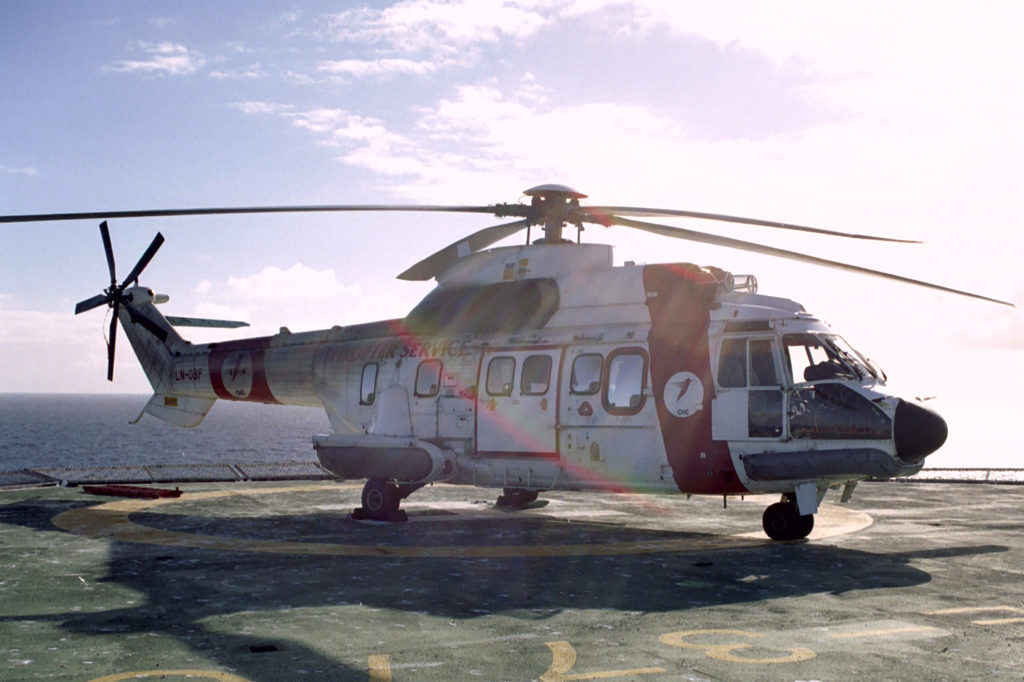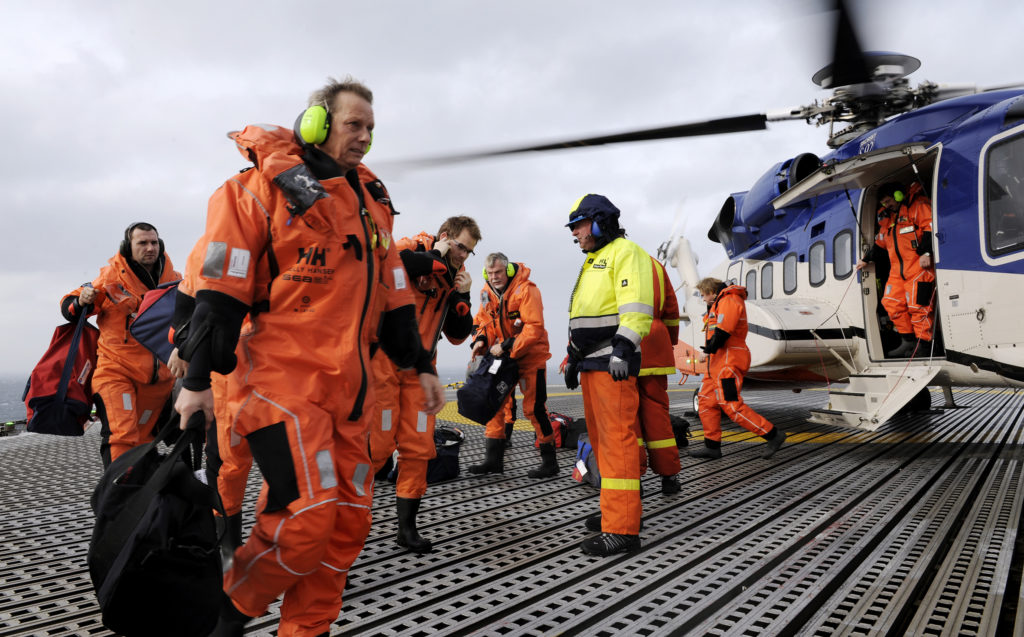Emergency helicopter landing at Sola

“We were told to prepare to an emergency landing, so we put up our hoods and got ready”
He was recounting how he experienced the drama in the Super Puma helicopter which was forced to make an emergency landing at Sola airport outside Stavanger on 20 October 1998.[REMOVE]Fotnote: Bø, Trond, “Helikopter rakk Sola etter stans i én motor”, Aftenposten, 21 October 1998.
“We were told to prepare to an emergency landing, so we put up our hoods and got ready,” Johansen said.
Owned by Norsk Helikopter, the machine – with call sign LN-OND – was 20 minutes out and 2 000 feet above the North Sea when the pilots noticed a fault in one engine.
They had taken off from Sola’s heliport at 12.05 en route to the Tor platform in the Greater Ekofisk Area, where the passengers were going to be working.
The weather was fine, with a slight breeze and scattered clouds, and the wave height was 2.5 metres.[REMOVE]Fotnote: Yr.no, “Været som var 20. oktober 1998”, Ekofisk weather station. Downloaded from https://www.yr.no/sted/Norge/Hav/Ekofisk_m%C3%A5lestasjon/almanakk.html?dato=1998-10-20.
Finding that the helicopter had become unstable, the pilots determined that the rpm of the right-hand engine was very high. An unusually loud engine noise in the cockpit got steadily worse.
Taking no chances, the pilots sent a Mayday call three times. The joint rescue coordination centre (JRCC) leapt into action, with nearby helicopters and ships alerted. Several alarms were sounding in the cockpit, with the warning lights glowing. The pilots decided to switch off the faulty engine and ditch in the sea.
It was time to prepare the 14 passengers for an emergency landing by adopting the brace position – hands behind their heads and elbows in front while they bowed their heads. Everyone working offshore had drilled on this procedure many times in their safety courses. The helicopter was now down to 600 feet or about 180 metres, and continuing its descent.
The pilots then realised that they had misinterpreted the position. Rather than the right-hand engine, the problem lay with the one on the left which was running at a very low rpm. They managed to restart the right-hand engine and stop their descent at 500 feet. After rising to 1 000 feet, the pilots set a course for land while the JRCC and passengers were informed.
During the return flight, another of the company’s helicopters was directed towards LN-OND and a naval Sea King rescue machine took off from Sola to escort it to land.[REMOVE]Fotnote: Air Accident Investigation Board Norway. Alvorlig luftfartshendelse i Nordsjøen ved A 47, 20. oktober 1998, med Eurocopter AS 332L Super Puma, LN-OND (RAP 28/2000), 14 June 2000. Downloaded from https://www.aibn.no/Luftfart/Rapporter/2000-28.
Norske Helikopter decided to ground all its Super Pumas until the reason for the engine failure had been established. About 190 oil workers were stuck on land, while 165 could not return home from Ekofisk as planned.[REMOVE]Fotnote: Adresseavisen, “Kø i heli-trafikken”, 22 October 1998.
Investigation launched
The incident was reported to Norway’s Air Accident Investigation Board (HSL), which launched an investigation. Its report observed that helicopter engines regularly failed.
That could not be avoided. But the reason this particular incident took a serious turn was the misinterpretation of signals and alarms by the pilots.
Based on these indications, they reduced power on the wrong engine. That in turn meant the helicopter was practically without drive for a time.[REMOVE]Fotnote: Air Accident Investigation Board Norway. Alvorlig luftfartshendelse i Nordsjøen ved A 47, 20. oktober 1998, med Eurocopter AS 332L Super Puma, LN-OND (RAP 28/2000), 14 June 2000. Downloaded from https://www.aibn.no/Luftfart/Rapporter/2000-28.
The problem was that the two engines were connected to a common gearbox, which can make it difficult to determine which of them was in trouble.
A Eurocopter Super Puma operated by Norsk Helikopter had crashed in September the year before en route to Norne in the Norwegian Sea, with the loss of 12 lives.
Experience from that accident could have influenced the pilots’ choices and contributed to them taking over-hasty decisions.
The HSL concluded that a training programme was needed to make pilots better at dealing with engine problems. It also recommended improvements to warning lights on Super Pumas.
Confidence weakened
 Historie, 1998, helikopter nødlander på sola,
Historie, 1998, helikopter nødlander på sola,The unions were quick to express declining faith in these helicopters after a number of incidents. With the Norne accident still fresh in their minds, too, many were frightened to fly.[REMOVE]Fotnote: Storhaug, E E, “Misliker Super Puma”, Stavanger Aftenblad, 23 October 1998: 2.
However, it was the Super Puma which aroused concern rather than Norsk Helikopter. The unions praised the company for the way it had handled the position.
“We feel the systematic follow-up of this and other episodes by Norsk Helikopter is reassuring,” Terje Johansen in the Norwegian Oil and Petrochemical Workers Union (Nopef) told the NTB wire service.
“But we have limited confidence in this aircraft type after the Norne accident and the emergency landing off Egersund. The latest incident helps to weaken trust even further, so we’re looking forward to the replacement of the Super Puma with more modern machines.”[REMOVE]Fotnote: Veigård, E, “Vibrasjoner i helikopteret fem dager før nødlanding”, NTB, 22 October 1998.
Another aspect
The unions were also unhappy about the number of flights to and from Ekofisk.[REMOVE]Fotnote: Stavanger Aftenblad, “Urovekkende”, 21 October 1998. They wanted all unnecessary trips halted in order to reduce needless exposure to risk. In addition to travel to and from land, 150 people a day used helicopters for shuttling between different installations out on the field. The Phillips Petroleum management held frequent meetings with the unions in a bid to establish how the number of air travel movements could be reduced.
NPD assessment
 Fra 7-7 til 2-4, forsidebilde,
Fra 7-7 til 2-4, forsidebilde,The Ekofisk Committee union nevertheless felt it was making no progress with the operator. It raised the issue with the Norwegian Petroleum Directorate (NPD), which took a serious view of it. According to the union, the fact that 150 people were having to shuttle daily between Ekofisk installations did not within the terms of the collective agreement.
The NPD contacted Phillips and urged it to curb the extensive in-field air traffic. The company took the hint, and quickly managed to halve these shuttle transports.[REMOVE]Fotnote: Kvålvåg, S H, “Helikoptertrafikk halveres”, Stavanger Aftenblad, 6 November 1998.
Official inauguration of Ekofisk IIEkofisk Committee merges with Nopef